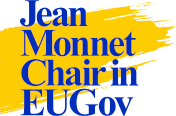Agenda setting

The agenda setting is the set of issues that are being discussed at a specific moment. According to the literature, there exist different types of agenda: The public agenda includes the issues that citizens find important. The media agenda consists of the issues that receive attention in the media, newspapers, magazines, television and their online versions. Finally, the political agenda includes the issues that policy makers are working on.
To analyze which type of issues are incorporated or excluded from the political agenda as well as which actors are involved in that decision, there are some theoretical perspectives that can help understanting the rising and fall of issues on the EU agenda. One of the most important approaches is the "multiple streams" model created by John Kingdom (2003).
According to the multiple streams model, policy-making processes consist of three streams that involve different and separate dynamics.
-
The problem stream consists of problem perception among policy makers.
-
The solution stream consists of proposals for government action.
-
The politics stream consists of political activities and developments, such as elections, or lobbying campaigns.
According to the model, these streams develop in isolation from each other. However, there are some moments in which they come together. This means that if the problem is seen as truly important, a feasible solution is available and the political context is favorable to the policy. This crossing moment is defined as Policy Window. When a window opens, an issue moves to the top of the political agenda.
Policy windows can have multiple origins. For example, when there is a dramatic situation that focuses attention on a problem that was not previously considered. This is an example of a "problem window" because its origin occurs in the problem stream. However, there can be other origins such as the change of a government. Indeed, a new government may have different priorities.
The link between the three streams is stimulated by policy entrepreneurs: individuals who actively try to bring the problems and solutions together.
To arrive at the top of the agenda one of the crucial roles is played by the way issues are defined. The definition of a problem is not a given, but something that political actors actively try to influence. The term that is used for problem definition is Policy Frame.
Frames are important in the agenda-setting processes, but they are only one side. The other side is formed by what Baumgartner and Jones (1993) call Policy Venues. Venues are the institutional forums in which decisions are taken on policies. However, the institutional structures are also not neutral. The competence and distribution of institutions determine some bias in favour of some issues and against others. This means that the organization can also be subject to bias.
In the European Union, Agenda-Setting powers are generally entrusted to the European Council. This sets the overall political direction - but has no powers to pass laws. Equally, the various EU institutions also have their own political agendas.
To improve your knowledge about EU agenda setting we suggest:
Kingdom, J. (2003) Agendas, Alternatives and Public Policies, 2nd edn (New York: HarperCollins College Publishers).
Princen, S. (2009) Agenda-setting in the European Union (Basingtoke and New York: Palgrave Macmillan).
Princen, S. (2011). Agenda-setting strategies in EU policy processes. Journal of European Public Policiy, 18(7), 927-943. DOI: 10.1080/13501763.2011.599960
Updated material:
Haverland, M., de Ruiter, M. & Van de Walle, S. (2018). Agenda-setting by the European Commission. Seeking public opinion?. Journal of European Public Policy, 25(3), 327-345. DOI: 10.1080/13501763.2016.1249014
Oztas, B & Kreppel, A. (2021). Power or Luck? The Limitations of the European Commission's Agenda Setting Power and Autonomous Policy Influence. Journal of Common Market Studies, 60(2), 408-426. DOI: https://doi.org/10.1111/jcms.13242
